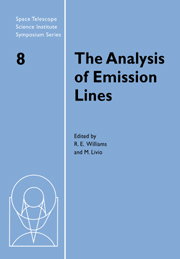Book contents
- Frontmatter
- Contents
- Participants
- Preface
- Emission Lines: Past and Future
- Atomic Data for the Analysis of Emission Lines
- Radiative Transfer
- Emission Lines from Winds
- Photoionizing Shocks
- The Lexington Benchmarks for Numerical Simulations of Nebulae
- Emission Line Diagnostics
- Ultraviolet Spectroscopy
- Infrared Emission Lines as Probes of Gaseous Nebulae
- Molecular Emission Line Diagnostics in Astrophysical Environments
- Abundance Determinations
- Astrophysical Gamma Ray Emission Lines
- Summary Remarks
Emission Lines from Winds
Published online by Cambridge University Press: 23 November 2009
- Frontmatter
- Contents
- Participants
- Preface
- Emission Lines: Past and Future
- Atomic Data for the Analysis of Emission Lines
- Radiative Transfer
- Emission Lines from Winds
- Photoionizing Shocks
- The Lexington Benchmarks for Numerical Simulations of Nebulae
- Emission Line Diagnostics
- Ultraviolet Spectroscopy
- Infrared Emission Lines as Probes of Gaseous Nebulae
- Molecular Emission Line Diagnostics in Astrophysical Environments
- Abundance Determinations
- Astrophysical Gamma Ray Emission Lines
- Summary Remarks
Summary
Some basic ideas about the origin of wind-formed line emission are presented. This is followed by three commentaries. The first focuses on the effects of clumped or inhomogeneous outflow on emission line formation, taking as examples the WR star HD 50896 and the Of star ζ Puppis. The second concerns wind-formed IR line emission: illustrations of the impact of overlapping continuum opacity on IR emission line spectra are presented, and the recent revolution in IR spectroscopy is demonstrated in the context of observations of highly-obscured luminous young stellar objects. Lastly, emission brought about by departures from spherical-symmetry is considered. Particular reference is made to the case of mass loss from the disk-accreting components located in cataclysmic binaries. HST data indicating a disk origin for the outflow are discussed briefly.
An overview
The classical spectroscopic signature of mass loss, first reviewed in the literature by Beals (1950), is the so-called P Cygni line profile. This label has come to be attached to the profile shape in which blueshifted absorption sits alongside redshifted emission. In truth, the practice of describing just this configuration as ‘P Cygni’ does little justice to the rich variety of profile forms that are to be found in this famous star's optical spectrum—Beals himself put the case for 4 different profile types characteristic of ‘P Cygni stars.’ Interestingly, from the perspective of this collection of papers on line emission, these other forgotten types include forms that emphasise emission rather than absorption. Indeed, those of us who have taken spectra of P Cygni itself are painfully aware of just how strong the strongest emission features (in Hα, He i λ5876) really are!
- Type
- Chapter
- Information
- The Analysis of Emission Lines , pp. 49 - 64Publisher: Cambridge University PressPrint publication year: 1995
- 4
- Cited by



